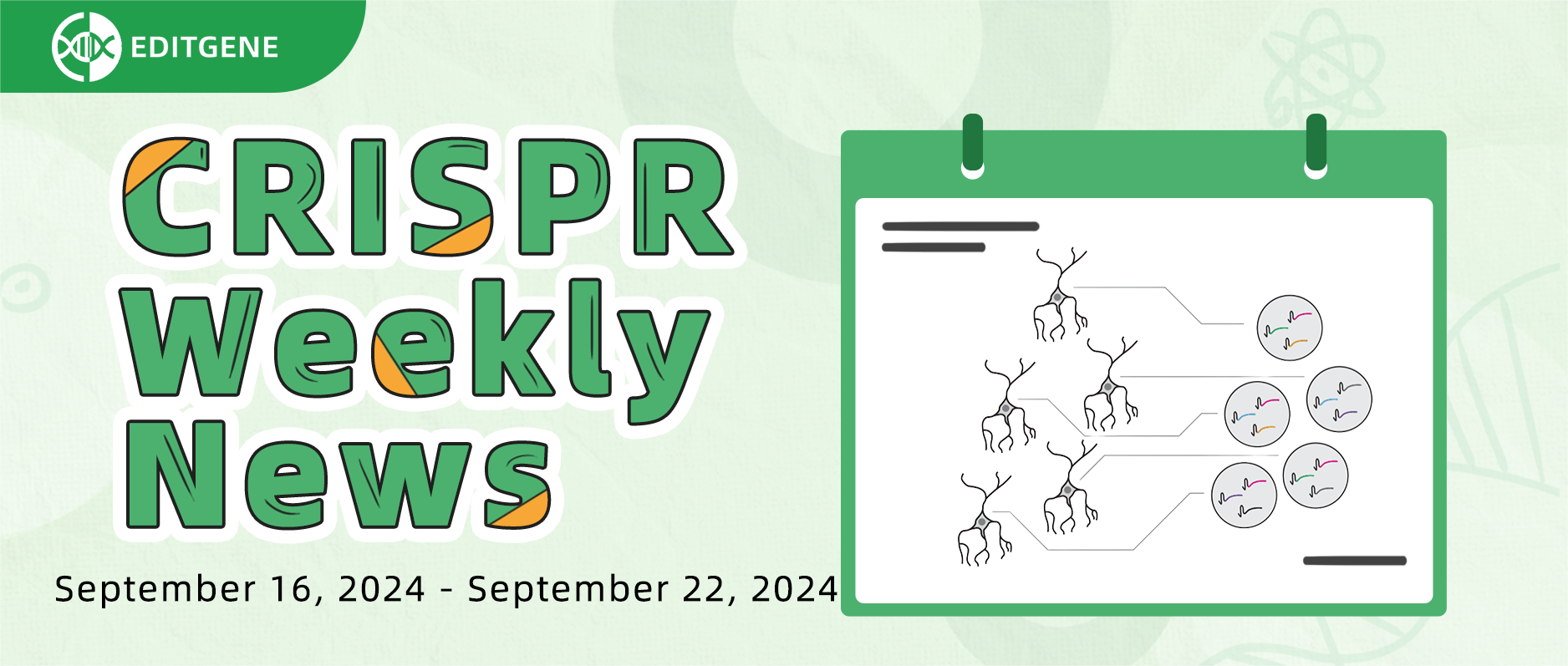[Weekly News] CRISPRa and Single-Cell RNA Sequencing Uncover Unique Regulatory Patterns Between Cell Types

CRISPR/Cas technology is a revolutionary tool in modern bioscience, with applications extending across medicine, agriculture, ecological conservation, and more. Breakthroughs and real-world examples continue to emerge. To keep you updated, the "CRISPR Weekly News" section brings you the latest research and industry news. Here's a brief summary of last week's top headlines:
I. Research Updates
i. CRISPR Screening
Title: In vivo CRISPR screens identify Mga as an immunotherapy target in triple-negative breast cancer
Journal: Medical Sciences (Impact Factor: 9.4)
Original Link: https://doi.org/10.1073/pnas.2406325121
Researchers from Nanjing Medical University in China and the University of Texas in the U.S. conducted CRISPR screens across multiple tumor models to identify immune evasion pathways, highlighting Mga as a key regulator. In triple-negative breast cancer (TNBC), Mga knockout enhanced anti-tumor immunity and suppressed tumor growth. Transcriptomic analysis revealed its impact on immune-related pathways. Notably, lower Mga expression in breast cancer patients was associated with better prognosis, suggesting Mga as a potential therapeutic target for regulating immune responses in TNBC.
ii. CRISPR Detection
1. Title: An electrochemical biosensor based on mild reduction-activated CRISPR/Cas12a system for sensitive detection of circulating tumor cells
Journal: Biosensors and Bioelectronics (Impact Factor: 10.7)
Original Link: https://doi.org/10.1016/j.bios.2024.116550
Researchers from Nanjing University, Shanghai University, and Jiangnan University developed an electrochemical biosensor for detecting circulating tumor cells (CTCs) in breast cancer using folate receptor targeting and CRISPR-Cas12a for signal amplification. Folate-coated magnetic beads were used to capture CTCs, with mild reduction exposing cell thiols to activate CRISPR. This system achieved high sensitivity detection (as low as 2 cells/mL) with strong selectivity and stability, offering a promising tool for CTC analysis in complex environments.
2. Title:Label-Free and Universal CRISPR/Cas12a-Based Detection Platform for Nucleic Acid Biomarkers
Journal: ACS Sensors (Impact Factor: 8.2)
Original Link: https://doi.org/10.1021/acssensors.4c01233
To overcome the limitations of traditional CRISPR detection methods, which require complex modifications and labeling of reporter genes, researchers from the Changchun Institute of Applied Chemistry, Chinese Academy of Sciences, developed a CRISPR/Cas12a detection system using a hairpin G-quadruplex (G4) as the reporter gene. The design of the G4 hairpin structure enhances Cas12a cleavage efficiency and the signal strength of the G4-binding ligand. The incorporation of protoporphyrin IX dye eliminates the need for complex modifications, enabling rapid and label-free detection of clinical samples. This platform is applicable to a variety of targets, including ssDNA, dsDNA, genomic RNA, and miRNA.
iii. CRISPR Gene Interference
1. Title: Epigenetic editing alleviates Angelman syndrome phenotype in mice by unsilencing paternal Ube3a
Journal: Cell Discovery (Impact Factor: 13.0)
Original Link: https://doi.org/10.1038/s41421-024-00727-3
Angelman syndrome (AS) is caused by the loss of UBE3A expression in neurons, where the paternal UBE3A copy is silenced by UBE3A-ATS. Researchers from ShanghaiTech University and the Shanghai Institute for Biological Sciences, Chinese Academy of Sciences, used CRISPR-dCas9 fused with a peptide recruiting DNA methyltransferase to achieve targeted DNA methylation at the Snrpn-IC locus, silencing UBE3A-ATS and restoring paternal UBE3A expression in mice. This epigenetic editing method alleviated AS symptoms, offering a promising non-invasive therapeutic strategy for AS treatment.
2. Title: Therapeutic CRISPR epigenome editing of inflammatory receptors in the intervertebral disc
Journal: Molecular Therapy (Impact Factor: 12.1)
Original Link: https://doi.org/10.1016/j.ymthe.2024.09.022
In search of methods to alleviate lower back pain, researchers from the University of Utah applied CRISPR interference (CRISPRi) epigenome editing to target TNFR1 in a rat model of intervertebral disc degeneration. By modulating TNFR1 signaling, the researchers observed reduced pain behaviors and a slowing of disc degeneration. Notably, TNF-α injections became therapeutic after TNFR1 modulation, highlighting CRISPR-Cas as a promising approach for treating inflammation-driven disc degeneration. These findings suggest that receptor-specific epigenome editing could be a novel strategy for treating lower back pain.
iv. Other CRISPR-Related Research
1. Title: Multiplex, single-cell CRISPRa screening for cell type specific regulatory elements
Journal: Nature Communications (Impact Factor: 14.7)
Original Link: https://doi.org/10.1038/s41467-024-52490-4
A novel method combining multiplex CRISPR-based gene activation (CRISPRa) with single-cell RNA sequencing (sc-RNA-seq) was developed to identify cis-regulatory elements that control gene expression in a cell-type-specific manner. Researchers in the U.S. applied this new approach to chronic myeloid leukemia cells (K562) and iPSC-derived excitatory neurons, uncovering distinct regulatory patterns between different cell types.
2. Title: Highly efficient CRISPR-mediated genome editing through microfluidic droplet cell mechanoporation
Journal: Nature Communications (Impact Factor: 14.7)
Original Link: https://doi.org/10.1038/s41467-024-52493-1
Researchers from Korea University have introduced a novel microfluidic platform called Droplet Cell Pincher (DCP) to enhance CRISPR-Cas9 genome editing. This system combines droplet microfluidics with cell mechanoporation, delivering CRISPR components into cells with higher efficiency and minimal cell damage, outperforming traditional methods like electroporation. The DCP platform uses a microfluidic system to encapsulate cells in droplets, which then pass through micro-scale constrictions, creating transient disruptions in the cell membrane. This facilitates the entry of CRISPR-Cas9 ribonucleoprotein (RNP) complexes.
II. Industry News
1. NanoVation Therapeutics has partnered with Novo Nordisk to develop gene therapies targeting cardiometabolic and rare diseases. The collaboration focuses on using NanoVation's lipid nanoparticle (lcLNP™) technology to deliver nucleic acids to cells outside the liver. This multi-year deal, with payments of up to $600 million, aims to develop base editing therapies and expand Novo Nordisk’s capabilities in gene medicines.
2. Excision BioTherapeutics presented promising data for EBT-107, a dual-guide RNA CRISPR therapy targeting hepatitis B, at the 2024 International HBV Meeting. The nanoparticle-delivered therapy demonstrated significant inhibition of HBV biomarkers both in vitro and in vivo, targeting covalently closed circular DNA (cccDNA) to address persistent viral infection.
3. Papillon Therapeutics has received FDA orphan drug designation for PPL-001, its experimental therapy for treating Friedreich’s ataxia. PPL-001 uses gene-corrected CD34+ stem cells to target GAA repeat expansions in the FXN gene, addressing the root cause of the disease. Preclinical studies show potential to reverse disease progression across multiple organ systems.
4. Chroma Medicine demonstrated that CRMA-1001, an epigenetic editor, achieved robust and durable silencing of hepatitis B in preclinical models. A single dose reduced hepatitis B surface antigen (HBsAg) levels by over 99%, with effects lasting more than six months. CRMA-1001 silences HBV DNA without cutting it, showing high specificity and the potential for transformative functional cures in patients with chronic hepatitis B.
EDITGENE focuses on CRISPR technology, offering a range of high-quality gene editing services and in vitro diagnostic products.
These include but are not limited to: CRISPR Library Screening, Cell Line Engineering, Monoclonal Cell Line Screening, CRISPR Detection.
We are committed to providing the most efficient technical services for CRISPR-related, gene function research, in vitro diagnostics, and therapeutic research.
Recent Blogs:
2.[Literature Review] CRISPR Knockout Provides Novel Insight into CENP-E-mediated Cell Division
3.[Weekly News] CRISPR screening reveals new mechanism: IL-4 contributes to CD8+ CART cell failure
Follow us on social media
Contact us
+ 833-226-3234 (USA Toll-free)
+1-224-345-1927 (USA)
info@editxor.com









![[Weekly News] CRISPRa and Single-Cell RNA Sequencing Uncover Unique Regulatory Patterns Between Cell Types](/uploads/20241026/VO6FbWHz1XqNhLJv_ce9a01bd08f9d18c7d09fad585bc559f.jpg)

Comment (4)